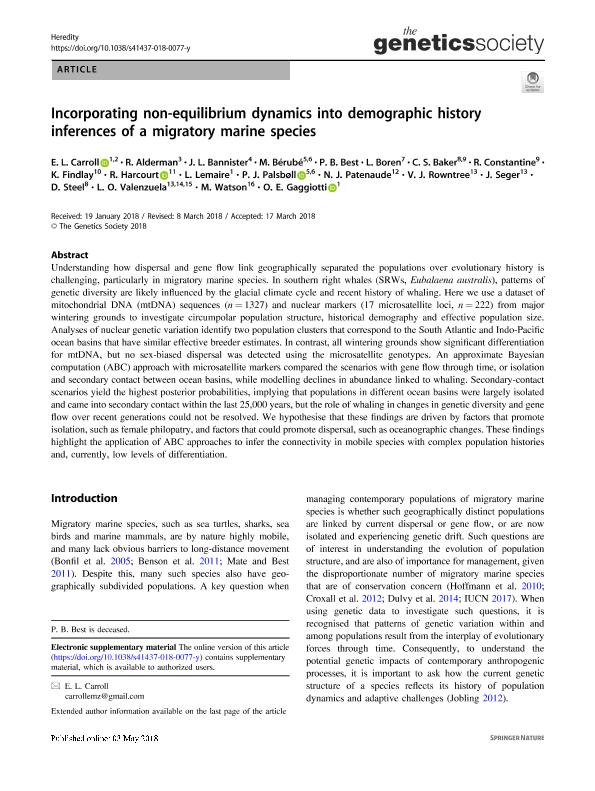Mostrar el registro sencillo del ítem
dc.contributor.author
Carroll, E. L.
dc.contributor.author
Alderman, R.
dc.contributor.author
Bannister, J. L.
dc.contributor.author
Bérubé, M.
dc.contributor.author
Best, P. B.
dc.contributor.author
Boren, L.
dc.contributor.author
Baker, C. S.
dc.contributor.author
Constantine, R.
dc.contributor.author
Findlay, K.
dc.contributor.author
Harcourt, R.
dc.contributor.author
Lemaire, L.
dc.contributor.author
Palsbøll, P. J.
dc.contributor.author
Patenaude, N. J.
dc.contributor.author
Rowntree, V. J.
dc.contributor.author
Seger, J.
dc.contributor.author
Steel, D.
dc.contributor.author
Valenzuela, Luciano Oscar

dc.contributor.author
Watson, M.
dc.contributor.author
Gaggiotti, O. E.
dc.date.available
2020-01-30T19:30:53Z
dc.date.issued
2019-01
dc.identifier.citation
Carroll, E. L.; Alderman, R.; Bannister, J. L.; Bérubé, M.; Best, P. B.; et al.; Incorporating non-equilibrium dynamics into demographic history inferences of a migratory marine species; Nature Publishing Group; Heredity; 122; 1; 1-2019; 53-68
dc.identifier.issn
0018-067X
dc.identifier.uri
http://hdl.handle.net/11336/96266
dc.description.abstract
Understanding how dispersal and gene flow link geographically separated the populations over evolutionary history is challenging, particularly in migratory marine species. In southern right whales (SRWs, Eubalaena australis), patterns of genetic diversity are likely influenced by the glacial climate cycle and recent history of whaling. Here we use a dataset of mitochondrial DNA (mtDNA) sequences (n = 1327) and nuclear markers (17 microsatellite loci, n = 222) from major wintering grounds to investigate circumpolar population structure, historical demography and effective population size. Analyses of nuclear genetic variation identify two population clusters that correspond to the South Atlantic and Indo-Pacific ocean basins that have similar effective breeder estimates. In contrast, all wintering grounds show significant differentiation for mtDNA, but no sex-biased dispersal was detected using the microsatellite genotypes. An approximate Bayesian computation (ABC) approach with microsatellite markers compared the scenarios with gene flow through time, or isolation and secondary contact between ocean basins, while modelling declines in abundance linked to whaling. Secondary-contact scenarios yield the highest posterior probabilities, implying that populations in different ocean basins were largely isolated and came into secondary contact within the last 25,000 years, but the role of whaling in changes in genetic diversity and gene flow over recent generations could not be resolved. We hypothesise that these findings are driven by factors that promote isolation, such as female philopatry, and factors that could promote dispersal, such as oceanographic changes. These findings highlight the application of ABC approaches to infer the connectivity in mobile species with complex population histories and, currently, low levels of differentiation.
dc.format
application/pdf
dc.language.iso
eng
dc.publisher
Nature Publishing Group

dc.rights
info:eu-repo/semantics/openAccess
dc.rights.uri
https://creativecommons.org/licenses/by-nc-sa/2.5/ar/
dc.subject.classification
Genética y Herencia

dc.subject.classification
Ciencias Biológicas

dc.subject.classification
CIENCIAS NATURALES Y EXACTAS

dc.subject.classification
Biología Marina, Limnología

dc.subject.classification
Ciencias Biológicas

dc.subject.classification
CIENCIAS NATURALES Y EXACTAS

dc.title
Incorporating non-equilibrium dynamics into demographic history inferences of a migratory marine species
dc.type
info:eu-repo/semantics/article
dc.type
info:ar-repo/semantics/artículo
dc.type
info:eu-repo/semantics/publishedVersion
dc.date.updated
2020-01-29T22:37:33Z
dc.journal.volume
122
dc.journal.number
1
dc.journal.pagination
53-68
dc.journal.pais
Reino Unido

dc.journal.ciudad
Londres
dc.description.fil
Fil: Carroll, E. L.. University of St. Andrews; Reino Unido
dc.description.fil
Fil: Alderman, R.. Water and Environment; Australia
dc.description.fil
Fil: Bannister, J. L.. The Western Australian Museum; Australia
dc.description.fil
Fil: Bérubé, M.. University of Groningen; Países Bajos
dc.description.fil
Fil: Best, P. B.. No especifica;
dc.description.fil
Fil: Boren, L.. New Zealand Department of Conservation; Nueva Zelanda
dc.description.fil
Fil: Baker, C. S.. State University of Oregon; Estados Unidos. University of Auckland; Nueva Zelanda
dc.description.fil
Fil: Constantine, R.. University of Auckland; Nueva Zelanda
dc.description.fil
Fil: Findlay, K.. Cape Peninsula University of Technology; Sudáfrica
dc.description.fil
Fil: Harcourt, R.. Macquarie University; Australia
dc.description.fil
Fil: Lemaire, L.. University of St. Andrews; Reino Unido
dc.description.fil
Fil: Palsbøll, P. J.. University of Groningen; Países Bajos
dc.description.fil
Fil: Patenaude, N. J.. Collégial International Sainte-Anne; Canadá
dc.description.fil
Fil: Rowntree, V. J.. University of Utah; Estados Unidos
dc.description.fil
Fil: Seger, J.. University of Utah; Estados Unidos
dc.description.fil
Fil: Steel, D.. State University of Oregon; Estados Unidos
dc.description.fil
Fil: Valenzuela, Luciano Oscar. University of Utah; Estados Unidos. Universidad Nacional del Centro de la Provincia de Buenos Aires; Argentina. Consejo Nacional de Investigaciones Científicas y Técnicas; Argentina
dc.description.fil
Fil: Watson, M.. Water and Planning; Australia
dc.description.fil
Fil: Gaggiotti, O. E.. University of St. Andrews; Reino Unido
dc.journal.title
Heredity

dc.relation.alternativeid
info:eu-repo/semantics/altIdentifier/url/https://www.nature.com/articles/s41437-018-0077-y
dc.relation.alternativeid
info:eu-repo/semantics/altIdentifier/doi/http://dx.doi.org/10.1038/s41437-018-0077-y
Archivos asociados
